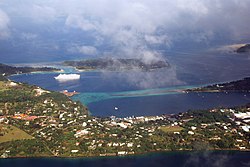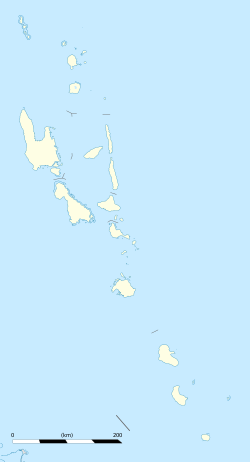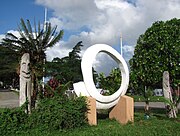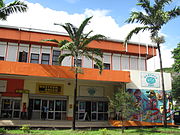|
Port Vila
Port Vila (/ˈviːlə/ VEE-lə; French: Port-Vila [pɔʁ vila]), or simply Vila (Bislama: [viˈla]), is the capital of Vanuatu and its largest city. It is on the island of Efate, in Shefa Province. The population was 49,034 as of the 2020 census.[2] In 2020, the population of Port Vila formed 16.3% of the country's population. Located on the east coast of the island of Efate, Port Vila is the economic and commercial centre of Vanuatu. The mayor is Jenny Regenvanu of the Land and Justice Party, the first woman to hold the position, elected in August 2024. Her deputy is Marie Louise Milne, of the Green Confederation.[3] NameLocally, the town is most commonly referred to simply as "Vila", whether in French or Bislama [viˈla] or in English /ˈviːlə/ VEE-lə (not like English "villa").[4][5][6] The name of the area is Efil in the native South Efate language and Ifira in neighbouring Mele-Fila language. Vila is a variant of these names. Ifira is a small island in Vila harbour where many traditional landowners reside. HistoryMelanesian people have occupied the Port Vila area for thousands of years. In the autumn of 2004, an archaeological expedition known as Teouma discovered a burial site of 25 tombs containing three dozen skeletons of members of the Lapita culture. Pieces of ceramics found at the site were dated to the 13th century BC.[citation needed] Efate Island was charted in 1774 by James Cook, who named it Sandwich Island. Cook's expedition did not land but noted the presence of good harbours and land suitable for European settlement. In the late 19th century, when the islands were known as the New Hebrides, the British initially had the dominant European presence. However, by the 1890s, the economic balance had begun favouring the French, who established large plantations. French citizen Ferdinand Chevillard began buying and clearing land around Port Vila to be converted into the largest French plantation on the island. Instead, it was converted into the municipality of Franceville, which declared independence on 9 August 1889, though this only lasted until June of the following year.[citation needed] After 1887, the territory was jointly administered by the French and the British. This was formalized in 1906 as an Anglo-French Condominium. During World War II, Port Vila was an American and Australian airbase.[citation needed] In 1987, Cyclone Uma severely damaged the city.[7] A powerful earthquake on 3 January 2002 caused minor damage in the capital and surrounding areas.[8] The city suffered massive damage from a category 5 cyclone named Cyclone Pam on 13 March 2015, whose eye wall passed just to the east of Port Vila.[9] On 17 December 2024, a magnitude 7.3 earthquake reportedly damaged almost every single house in Port Vila, resulting in 16 fatalities.[10] The United Nations Office for the Coordination of Humanitarian Affairs estimated that 116,000 people had been directly affected by the earthquake,[11] equivalent to a third of Vanuatu's population.[12] GeographyClimatePort Vila has a tropical climate, more specifically a tropical rainforest climate, with noticeably wetter and drier months. As the trade winds are almost permanent and cyclones are not rare in Port Vila, the climate is not equatorial but maritime trade-wind tropical climate.[13] Rainfall averages about 2,338.9 millimetres or 92.08 inches per year, and the wettest month is March. The driest month is September. There are 153 wet days in an average year. The area also has south-east trade winds. Temperatures do not vary much throughout the year, and the record high is 35.6 °C or 96.1 °F. The coolest month, July, has an average high of 27 °C or 80.6 °F, and an average low of 18 °C or 64.4 °F. The hottest month, February, has an average high of 31.2 °C or 88.2 °F and an average low of 23 °C or 73.4 °F. The record low for Port Vila is 8.5 °C or 47.3 °F. Humidity is often high.
Economy and transportPort Vila is Vanuatu's most important harbour and the center of the country's trade. The international airport, Bauerfield International (VLI), is also located in the city. Air Vanuatu has its head office in Vanuatu House in Port Vila.[16] Major industries in the city remain agriculture and fishing. Tourism is also becoming important, especially from Australia and New Zealand. There were over 80,000 visitors in 1997.[17] Vanuatu is a tax haven, and offshore financing in Port Vila is an important part of the economy. Vanuatu is still dependent on foreign aid, most of which comes from Australia and New Zealand, although in recent years, assistance has also come from China. One example was New Zealand paying to train doctors selected from the local community, then paying part of their wages during the first year after qualification. Australia has paid consultants to work in Port Vila Central Hospital. 35.7% of exports leave from Port Vila, and 86.9% of imports arrive in Port Vila.[citation needed] PopulationDemographics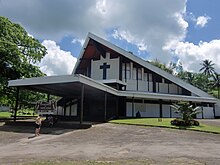 The population is around 45,000; predominately Melanesian, with small Polynesian, Asian, Australian and European populations, mainly French and British. LanguagesPort Vila is home to many languages, reflecting the country's high linguistic diversity. The capital city's daily lingua franca is Bislama, but English and French are also widely spoken. Among Vanuatu's 100 indigenous languages, many are spoken in the capital, as people from rural areas come to live in the city, either temporarily or permanently. ReligionChristianity is the predominant religion across Vanuatu, followed by more than 90% of the population. The largest denomination is the Presbyterian Church in Vanuatu, followed by one-third of the population. Roman Catholicism and the Church of Melanesia are also common, each about 15%. Cathédrale du Sacré-Cœur is a modern Roman Catholic cathedral in Port Vila. The seat of the Diocese of Port Vila,[18] the church is dedicated to the Sacred Heart of Jesus.[19] On October 5, 2020, The Church of Jesus Christ of Latter-Day Saints announced plans to construct a temple in the city, and the Baháʼí Faith community is also established in Port Vila.[20] Culture and educationHighlights of the cityThe capital of Vanuatu has various sights to offer. There are several memorials, e.g., opposite the Parliament, where two traditional totem poles and a monument representing a pig's tusk can be seen. The Presbyterian Church of Port Vila is an impressive and sightworthy building opposite the Independence Park. A colourful wall painting can be seen on the administration building opposite the market hall. Another noteworthy wall painting is on the façade of the post office. The City Hall of Port Vila is an oblong and sightworthy building on a hill in the city centre. Cityscape
Vanuatu Cultural CentreThe Vanuatu Cultural Centre, hosting the Vanuatu National Museum, is located at the Saralana Park in front of the National Parliament, close to the National Library and the Malvatumauri (Vanuatu National Council of Chiefs). This institution is an important place to preserve and promote the different aspects of the local culture. Traditional artifacts from several islands are on display in the museum. The centre also hosts the National Audiovisual Archives, the most critical fund of documents from the late 19th century until today. World HeritagePort Vila was the location in August 1999 for the "2nd World Heritage Global Strategy Meeting for the Pacific Islands Region" held by UNESCO. One of the major topics related to Vanuatu and the Pacific region was the question of the suitability of underwater heritage for inscription on the World Heritage List.[21] Education
Port Vila is one location of the University of the South Pacific, an educational institution co-owned by twelve Pacific countries. The Vanuatu campus is the only law school in the university and teaches languages. Upper secondary (sixth form/senior high school) institutions include:
Junior secondary (seventh form to tenth form) institutions include:
InstitutionsMunicipalityThe municipality of Port Vila is divided into four wards and administered by a council of 14 members. The four wards are:
Malapoa-Tagabe and South are allotted three representatives each to the council, while Anabrou-Melcofe-Tassiriki and Centre have four.[22] The municipality handles primary education, primary health care, regional planning, road maintenance and construction, trash collection, cemeteries, parks and open spaces, and tourism promotion. There are also informal settlements such as Blacksands, which are effectively Vila suburbs but outside the municipality. Living conditions in some of these neighbourhoods are deplorable. Lack of service provision and insecure land tenure are major problems.[23] Blacksands was squatted in the 1960s.[24] The most recent municipal council election was held in 2022. Constituency
Port Vila is one of the eighteen constituencies in Vanuatu and elects six Members of Parliament. Following the 2016 general election, its representatives are:[25]
TransportationPort Vila is served by Bauerfield International Airport, with service on many passenger and cargo airlines, including several foreign ones. Twin towns – sister citiesPort Vila is twinned with: References
External linksWikivoyage has a travel guide for Port Vila.
|
||||||||||||||||||||||||||||||||||||||||||||||||||||||||||||||||||||||||||||||||||||||||||||||||||||||||||||||||||||||||||||||||||||||||||||||||||||||||||||||||||||||||||||||||||||||||||||||||||||||||||||||||||||||||||||||||||||||||||||||||||||||||||||||||||||||||||||||
